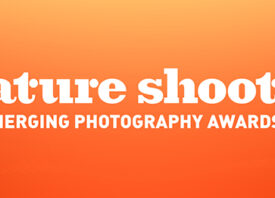Search this site
Announcing the Winners of the Feature Shoot Emerging Photography Awards

After reviewing hundreds of outstanding submissions, we’re delighted to announce the thirteen winners of the 6th Annual Feature Shoot Emerging Photography Awards. This year’s jury selected ten photographers to exhibit their work as part of a poster run in select locations throughout the streets of East London. Three photographers were chosen to be part of the FORMAT International Photography Festival in Derby.
The ten photographers chosen to show in East London are Antonio Faccilongo, Rashod Taylor, Mirja Maria Thiel, Ursula Ferrara, Shaun Pierson, Donavon Smallwood, Manon Ouimet, Sergey Pesterev, Alison Luntz, and Renata Dutrée. Together, they span genres and continents, telling stories from the United States, the United Kingdom, Palestine, Germany, Italy, the Netherlands, Russia, and beyond.
The three photographers headed to the FORMAT International Photography Festival in Derby are Florence Goupil, Felix Schoeppner, and Christopher Sims, hailing from Peru, Germany, and the United States, respectively. Learn about all the winners below.

The Italian documentary photographer Antonio Faccilongo‘s project Habibi takes us on a journey into the lives and homes of Palestinian women whose husbands are serving long-term sentences in Israeli jails, revealing an untold love story unfolding against the complex backdrop of conflict and its aftermath.
“The Palestinian prisoners’ wives have turned to sperm smuggling in order to conceive children from their husbands,” the photographer writes. “In the last 7 years, according to the Razan Hospital in Nablus, which provides in vitro fertilization treatments in West Bank, around 100 babies have been born. These treatments are offered free of charge to these women because their husbands are considered by the collectivity as living martyrs who have renounced their freedom for the homeland.”

Little Black Boy is the Illinois-based photographer Rashod Taylor‘s ongoing exploration of fatherhood and the Black American experience, as told through pictures made in collaboration with his five-year-old son LJ. “As I document my son I am interested in examining his childhood and the world he navigates,” the artist writes.
“At the same time these images show my own unspoken anxiety and fragility as it pertains to the wellbeing of my son and fatherhood. At times I worry if he will be okay as he goes to school or as he plays outside with friends as children do. These feelings are enhanced due to the realities of growing up black in America.”
You can read more about the series here.

The German photographer Mirja Maria Thiel captures underrepresented stories of intimacy, desire, sexuality, and tenderness among older couples in her project All This Love. “Against the background of aging societies, this life-affirming issue should be included in the discourse about old age,” Thiel says. “The aim of this ongoing series is to highlight love stories, mutual sexual attraction, and intimate moments of self-confident couples. Their images reflect their lived experience and attitude.”

The Italian artist Ursula Ferrara has been exploring analog photography since the age of 13, when she first used her father’s Leica. From there, she ventured into wet plate processes, self-built cameras, and even a camera van. Her series Garbage shadows was created using the suspended shadows of items salvaged from the trash.

The New York-based photographer Shaun Pierson delves into his childhood memories and the concept of youth in his series Alvine Road, a collection of images he describes as combination of autobiography and fantasy.
“Drawing from fragmented pieces of my own memory, these photographs utilize members of my family in an effort to further explore the tumultuous nature of my childhood,” the photographer writes. “Through this work, I revisit the half-remembered memories from my childhood in an attempt to further understand myself, resulting in images that touch on subtopics such as childhood trauma, familial intimacy, and the disintegration of relationships.”

The American photographer Donavon Smallwood paints a portrait of the people and the landscape of New York’s Central Park in his project Languor. The artist writes, “With the history of Central Park using eminent domain to strip landowning African-Americans of their property, this project is an examination of nature, home, and escape.”

The London-based photographer Manon Ouimet explores the therapeutic potential of portraiture, while celebrating the beauty of humanity and empowering individuals, through her series Altered. “This body of photographic work focuses on individuals who have unwillingly embarked on life-changing body alterations due to illness, war, accidents and violence,” she writes.
“The intention is to illuminate people who often feel marginalised and contribute to conversations about equality and diversity. By combining a classical fashion aesthetic with a humanist focus, the work asks the viewer to explore themselves through the prism of others and to challenge or confirm their belief system regarding body image and its representation.”
You can read more about the work here.

In Kingdom of ice, the Russian-based photographer Sergey Pesterev brings us on a journey to southern Siberia–and the edges of the imagination–through pictures of Lake Baikal, the oldest and deepest lake on the planet. “Baikal was added to the World Heritage list by UNESCO in 1996,” Pesterev writes “The water in the lake is so transparent that individual stones and various objects can be seen at a depth of up 40 meters. In winter, this place turns into a kingdom of ice of various textures and shades from milk-white to emerald.”

Alison Luntz‘s self-portrait series In Spirit was made in her Brooklyn apartment during coronavirus lockdowns. “By posing in front of prints of my photography–snapshots and grainy film memories, I’m able to transport myself to places, people, and feelings from which I am cut off in the quarantined present,” she says. “This is an exploration of the vast space between longing and reality, and all the strange and wondrous ways they intersect.”

In her series Shadows of My Mind, the Dutch fine art photographer Renata Dutrée captures moments of mystery, apprehension, and escape against the backdrop of our uncertain times. “We find our lives in turmoil with Covid-19 amongst us,” she writes. “Feeling uncertain about what is to come, the loneliness, grief and despair, death, we try to look for consolation. These images hopefully offer some solace in a time where we seem to be disconnected not only to our environment but to ourselves as well.”

The Healing Plants is the photographer Florence Goupil‘s testament to the heritage, history, and landscape of the Shipibo-Konibo Indigenous people, whose leadership and vast knowledge of rainforest biodiversity and traditional plant-based medicine are under threat amid the coronavirus pandemic.
“The epicenter of the COVID-19 pandemic has moved to the Peruvian Amazon, endangering the lives of the indigenous Shipibo-Konibo people,” she writes. “This very complex situation has left the indigenous communities in total desolation as without sufficient resources, they cannot recover and the number of deaths in the Amazon continues to grow.
“Ronald Suárez, president of the indigenous organization Coshikox, lost his mother along with seven other relatives due to Covid-19. He states that the disappearance of the Shipibo-Konibo elders is extremely serious because with them goes the library of knowledge linked to the use of plants and the biodiversity of the Peruvian Amazon. Like Ronald, many Shipibo-Konibo consider this situation as a genocide by abandonment.”

Illustrating ideas, terms, and symbols from the fields of physics and astronomy, Felix Schoeppner‘s conceptual project Cognition explores the intersection between human perception and abstract thinking through mind-bending photographs of sculptures made inside the studio.

Christopher Sims takes us behind-the-scenes on the training grounds of U.S. military bases to visit fabricated, fictitious Iraqi and Afghan villages in his series The Pretend Villages. “The villages are situated in the deep forests of North Carolina and Louisiana, and in a great expanse of desert near Death Valley in California,” he writes.
“The villages serve as a strange and poignant way station for people heading off to war and for those who have fled it. U.S. soldiers interact with pretend villagers who are often recent immigrants from Iraq and Afghanistan, who have now found work in America playing a version of the lives they left behind.”



